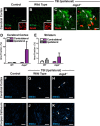Impairment of glymphatic pathway function promotes tau pathology after traumatic brain injury
- PMID: 25471560
- PMCID: PMC4252540
- DOI: 10.1523/JNEUROSCI.3020-14.2014
Impairment of glymphatic pathway function promotes tau pathology after traumatic brain injury
Abstract
Traumatic brain injury (TBI) is an established risk factor for the early development of dementia, including Alzheimer's disease, and the post-traumatic brain frequently exhibits neurofibrillary tangles comprised of aggregates of the protein tau. We have recently defined a brain-wide network of paravascular channels, termed the "glymphatic" pathway, along which CSF moves into and through the brain parenchyma, facilitating the clearance of interstitial solutes, including amyloid-β, from the brain. Here we demonstrate in mice that extracellular tau is cleared from the brain along these paravascular pathways. After TBI, glymphatic pathway function was reduced by ∼60%, with this impairment persisting for at least 1 month post injury. Genetic knock-out of the gene encoding the astroglial water channel aquaporin-4, which is importantly involved in paravascular interstitial solute clearance, exacerbated glymphatic pathway dysfunction after TBI and promoted the development of neurofibrillary pathology and neurodegeneration in the post-traumatic brain. These findings suggest that chronic impairment of glymphatic pathway function after TBI may be a key factor that renders the post-traumatic brain vulnerable to tau aggregation and the onset of neurodegeneration.
Keywords: AQP4; aquaporin-4; cerebrospinal fluid; neurodegeneration; tauopathy; traumatic brain injury.
Copyright © 2014 the authors 0270-6474/14/3416180-14$15.00/0.
Figures

Similar articles
-
Focal Solute Trapping and Global Glymphatic Pathway Impairment in a Murine Model of Multiple Microinfarcts.J Neurosci. 2017 Mar 15;37(11):2870-2877. doi: 10.1523/JNEUROSCI.2112-16.2017. Epub 2017 Feb 10. J Neurosci. 2017. PMID: 28188218 Free PMC article.
-
Aquaporin-4-dependent glymphatic solute transport in the rodent brain.Elife. 2018 Dec 18;7:e40070. doi: 10.7554/eLife.40070. Elife. 2018. PMID: 30561329 Free PMC article.
-
A paravascular pathway facilitates CSF flow through the brain parenchyma and the clearance of interstitial solutes, including amyloid β.Sci Transl Med. 2012 Aug 15;4(147):147ra111. doi: 10.1126/scitranslmed.3003748. Sci Transl Med. 2012. PMID: 22896675 Free PMC article.
-
A new glaucoma hypothesis: a role of glymphatic system dysfunction.Fluids Barriers CNS. 2015 Jun 29;12:16. doi: 10.1186/s12987-015-0012-z. Fluids Barriers CNS. 2015. PMID: 26118970 Free PMC article. Review.
-
The Emerging Relationship Between Interstitial Fluid-Cerebrospinal Fluid Exchange, Amyloid-β, and Sleep.Biol Psychiatry. 2018 Feb 15;83(4):328-336. doi: 10.1016/j.biopsych.2017.11.031. Epub 2017 Dec 7. Biol Psychiatry. 2018. PMID: 29279202 Free PMC article. Review.
Cited by 194 articles
-
Tau reduction in aged mice does not impact Microangiopathy.Acta Neuropathol Commun. 2020 Aug 18;8(1):137. doi: 10.1186/s40478-020-01014-4. Acta Neuropathol Commun. 2020. PMID: 32811565 Free PMC article.
-
Peri-arterial pathways for clearance of α-Synuclein and tau from the brain: Implications for the pathogenesis of dementias and for immunotherapy.Alzheimers Dement (Amst). 2020 Jul 28;12(1):e12070. doi: 10.1002/dad2.12070. eCollection 2020. Alzheimers Dement (Amst). 2020. PMID: 32782922 Free PMC article.
-
Omega-3 Polyunsaturated Fatty Acids Alleviate Traumatic Brain Injury by Regulating the Glymphatic Pathway in Mice.Front Neurol. 2020 Jul 17;11:707. doi: 10.3389/fneur.2020.00707. eCollection 2020. Front Neurol. 2020. PMID: 32765412 Free PMC article.
-
Persistent Neurovascular Unit Dysfunction: Pathophysiological Substrate and Trigger for Late-Onset Neurodegeneration After Traumatic Brain Injury.Front Neurosci. 2020 Jun 9;14:581. doi: 10.3389/fnins.2020.00581. eCollection 2020. Front Neurosci. 2020. PMID: 32581697 Free PMC article.
-
Magnetic Resonance Imaging and Modeling of the Glymphatic System.Diagnostics (Basel). 2020 May 27;10(6):344. doi: 10.3390/diagnostics10060344. Diagnostics (Basel). 2020. PMID: 32471025 Free PMC article. Review.
Publication types
MeSH terms
Substances
Grant support
LinkOut - more resources
-
Full Text Sources
-
Other Literature Sources
-
Molecular Biology Databases
-
Miscellaneous
